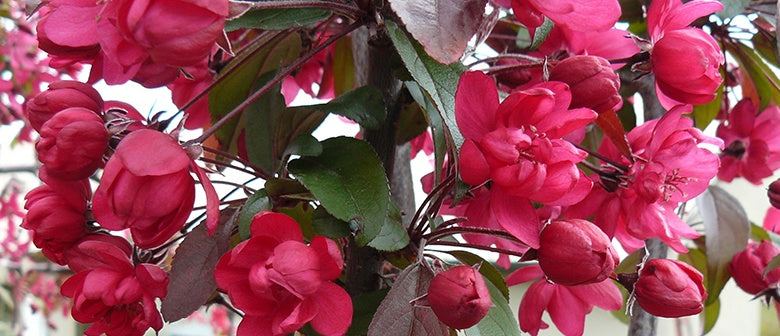Crab Apple: A Hard Working Tree
For those who love spring blossoms but have limited space, a Crab apple may be just what you’re looking for. As well as its tidy form and spectacular displays of large, double pink flowers, this trusty tree produces stunning dark red Spring foliage. The leaves turn dark green over summer then fiery red and gold in autumn, complementing the dark red fruit.
A hard-working tree
Crab apples are essentially the same as apples except that they bear smaller, tarter fruits. The trees themselves have a relaxed, open habit that offers both shelter and food for visiting birds.
The Crab apple is one of those rare trees that tick not one but all the boxes on the gardener’s checklist. It all starts in spring with a riot of coloured blossoms that draw in the pollinators as they stir from their Winter slumber. The trees are invaluable as a pollinating partner for other apples, so plant one within your mini orchard and you’re sure to boost the fruiting prospects of your other trees. Old-time orchardists would take branches of blooming Crab apples and put them in a bucket of water in the middle of their apple orchards. Bees would visit the Crab apple blossoms and then the apple blossoms as they opened, improving the fruit set.
Once the flowers have been pollinated, Crab apples come alive with their burgeoning fruits, borne in generous clusters! They are ready to pick from early Autumn and, just as the Spring blossom draws in the bees, any fruits left on the tree into Winter serve as a beacon to birds, putting your pad firmly on the map. As an established tree produces so many crabs – there’s more than enough for beasts, birds and bees alike! A final blaze of glory at leaf fall completes the joys of this eager-to-please beauty.
How to grow
The humble Crab apple isn’t hard to please – it’s happy in sun or light shade and in just about any soil. Get your tree off to a solid start by improving the soil quality by adding in some compost and sheep pellets or Rooster Booster before planting time. Pop your tree in a generous sized hole to allow the roots to have a good stretch. Once planted, give the tree a deep water.
Ongoing care is simple and straightforward. Water when the weather is dry for the first few years and apply mulch in early Spring to give your tree a boost for the new growing season. Pruning should be done in late Winter to remove, dead, dying or diseased branches, and if you wish, to maintain the shape. And that’s it, seriously.
How to eat them
What’s to be done with the small, sour fruit may not be immediately obvious. The answer lies in its high pectin and acid content, which makes it ideal for setting fruit jams. Pair it with berries and you’ll not only achieve a good set but a rich and flavourful jam. Traditional Crab apple jelly can be spruced up by adding a few chillies to the mix – a perfect combination of sweet-tart and gentle heat that’s a match made in heaven for serving with meats.
Crab Apple Jelly
Ingredients:
- 4kg Crab apples
- 1kg caster sugar
- 1 lemon, juiced
Makes 6 500ml jars – or use the proportions
1: Wash the Crab apples and put in a saucepan with enough water to just cover the fruit
2: Bring to the boil and simmer until the fruit is just soft, this should be about 30 minutes
3: Pour the pulp into a jelly bag or several layers of muslin and let drip overnight into a pan. Do not squeeze the bag as it can make the juice cloudy
4: The next day, measure the juice, and add sugar in the ratio of 10 parts juice to 7 of sugar. Add some lemon juice, then bring to the boil, stirring to dissolve the sugar
5: Keep at a rolling boil for 40 minutes, skimming off the froth. To test the set, chill a dessertspoon in the refrigerator
6: When the jelly is set, it will solidify on the back of the spoon. Pour into warm, sterilised preserving jars and tightly seal while still slightly warm. Store in a cool dark place.

